From inside (document excerpt):
Tire Pressure Monitor (TPM) System Tester Quick Start Guide IMPORTANT NOTICES SAFETY DEFINITIONS All Danger, Warning, Important, and Note messages must be followed for your safety. These safety messages are in the following formats: DANGER: Means you may risk possible loss of life. WARNING: Means you may risk possible bodily harm. CAUTION: Means you risk damage to the vehicle or the tool. NOTE: Provide clarity and helpful tips.
Power Tool User Manual Free Download. HAVC Operator’s Manual. Auto AC Lift Power Free Instruction Manual Download PDF.
These safety messages cover situations SPX is aware of. SPX cannot know, evaluate and advise you as to all of the possible hazards. You must be certain that any conditions or service procedures encountered do not jeopardize your personal safety. No part of this manual may be reproduced, stored in a retrieval system or transmitted, in any form or by any means, electronic, mechanical, photocopying, recording, or otherwise, without the prior written permission of SPX. DISCLAIMER All information, illustrations, and specifications contained in this technical instruction manual are based on the latest information available at the time of publication. The right is reserved to make changes at any time without obligation to notify any person or organization of such revisions or changes. Further, SPX shall not be liable for errors contained herein or for incidental or consequential damages (including lost profits) in connection with the furnishing, performance or use of this material. FCC COMPLIANCE OTC Tire Pressure Monitor Tester Model: TPM 3833-1 SPX Corporation FCC ID: RP3-3833 IC: 4811A-3833 This device complies with part 15 of the FCC Rules and with RSS-210 of Industry Canada. Operation is subject to the following two conditions: (1) this device may not cause harmful interference, and (2) this device must accept any interference received, including interference that may cause undesired operation. The term “IC: ” before the radio certification number only signifies that Industry Canada technical specifications were met. 2007 SPX Corporation. CONTENTS IMPORTANT NOTICES . inside front cover Safety Precautions ii How the TPM Tester Works . 1 Kit Components 2 Tester Components and Features . .2 Battery Stick and Charging Cradle . .3 Printer Components .4 Setup . 5 Batteries or Battery Stick .5 Printer . .7 Tester Language .10 Test Functions Overview 11 Auto Scan 12 Diagnostics . 14 Reset Procedure . 17 RKE Fob 21 Last Saved 22 Update Tool . 24 Appendix: Battery Charging Cradle . 25 SPX Corporation Limited Warranty . inside back cover TPM Tester Quick Start Guide i Safety Precautions DANGER: When an engine is operating, keep the service area WELL VENTILATED or attach a building exhaust removal system to the engine exhaust system. Engines produce carbon monoxide, an odorless, poisonous gas that causes slower reaction time and can lead to serious personal injury or loss of life. WARNINGS: · When working with hydraulic or fuel lines, liquids under pressure may escape and create a dangerous condition. Use adequate ventilation and make sure there are no sparks or possibility of sparks present that may ignite any vapor. Wear an American National Standards Institute (ANSI) approved eye shield when testing or repairing vehicles. Objects propelled by whirling engine components or pressurized liquids escaping may cause personal injury. Set the parking brake and block the wheels before testing or repairing a vehicle. It is especially important to block the wheels on front-wheel drive vehicles because the parking brake does not hold the drive wheels. Do not drive the vehicle and operate the tester at the same time. Any distractions may cause an accident. Have one person operate the tester as another person drives the vehicle. Maintain adequate clearance around moving components or belts during testing. Moving components and belts can catch loose clothing, body parts, or test equipment and cause serious damage or personal injury.


 Robinair SPX OTC 3833 Tire Pressure Monitor Tester Manual - 1 of 36
Robinair SPX OTC 3833 Tire Pressure Monitor Tester Manual - 1 of 36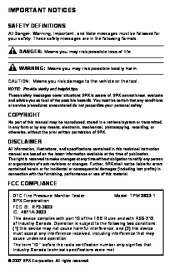 Robinair SPX OTC 3833 Tire Pressure Monitor Tester Manual - 2 of 36
Robinair SPX OTC 3833 Tire Pressure Monitor Tester Manual - 2 of 36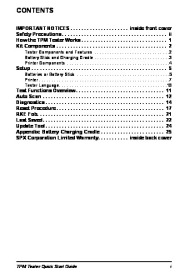 Robinair SPX OTC 3833 Tire Pressure Monitor Tester Manual - 3 of 36
Robinair SPX OTC 3833 Tire Pressure Monitor Tester Manual - 3 of 36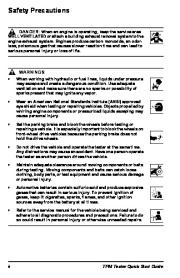 Robinair SPX OTC 3833 Tire Pressure Monitor Tester Manual - 4 of 36
Robinair SPX OTC 3833 Tire Pressure Monitor Tester Manual - 4 of 36 Robinair SPX OTC 3833 Tire Pressure Monitor Tester Manual - 5 of 36
Robinair SPX OTC 3833 Tire Pressure Monitor Tester Manual - 5 of 36 Robinair SPX OTC 3833 Tire Pressure Monitor Tester Manual - 6 of 36
Robinair SPX OTC 3833 Tire Pressure Monitor Tester Manual - 6 of 36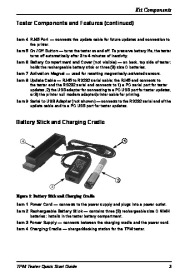 Robinair SPX OTC 3833 Tire Pressure Monitor Tester Manual - 7 of 36
Robinair SPX OTC 3833 Tire Pressure Monitor Tester Manual - 7 of 36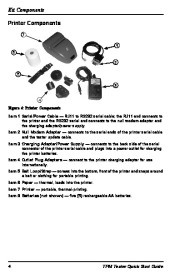 Robinair SPX OTC 3833 Tire Pressure Monitor Tester Manual - 8 of 36
Robinair SPX OTC 3833 Tire Pressure Monitor Tester Manual - 8 of 36 Robinair SPX OTC 3833 Tire Pressure Monitor Tester Manual - 9 of 36
Robinair SPX OTC 3833 Tire Pressure Monitor Tester Manual - 9 of 36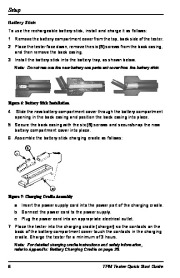 Robinair SPX OTC 3833 Tire Pressure Monitor Tester Manual - 10 of 36
Robinair SPX OTC 3833 Tire Pressure Monitor Tester Manual - 10 of 36